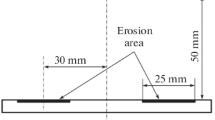Abstract
Material properties are greatly dependent upon the structure of the material. This paper, the first of three parts, discusses how composition influences the crystallographic structure and microstructure of lead lanthanum titanate (PLT) thin films grown by the multi-ion-beam reactive sputtering (MIBERS) technique. A transmission electron microscopy (TEM) study detailing the relationship between crystallographic texturing and microstructure development will be presented in a second paper. The dependence of the ferroelectric properties on observed crystallographic structure and microstructure is presented in the third paper of this series. As-deposited PLT microstructures coincide with the structure zone model (SZM) which has been developed to describe the microstructure of thin films deposited by physical vapor deposition. The as-deposited PLT structures are altered during post-deposition annealing as a result of crystallization and PbO evaporation. Amorphous films with more than 10 mole % excess PbO become polycrystalline with porous microstructures after annealing. When there is less PbO in the as-deposited film, 〈100〉 texture and dense structures are observed. Porosity results from PbO evaporation, and 〈100〉 texture is inhibited by excess PbO.
Similar content being viewed by others
References
C.A. Paz de Araujo and G.W. Taylor, Ferroelectrics 116, 215 (1991).
R. Takayama, Y. Tomita, K. Iijima, and I. Ueda, J. Appl. Phys. 61 (1), 411 (1987).
H. Adachi, T. Mitsuyu, O. Yamazaki, and K. Wasa, Jpn. J. Appl. Phys., Supplement 24-2 24, 287 (1985).
C. E. Land, J. Am. Ceram. Soc. 72 (11), 2059 (1989).
R. Roy, J. Am. Ceram. Soc. 60, 350 (1977).
R. E. Newnham, Structure-Property Relations (Springer-Verlag, Berlin, Germany, 1975).
V.M. Goldschmidt, Skr. Nor. Vidensk-Akad. Oslo, I 1926 (8), 156 (1927).
L. Pauling, The Nature of the Chemical Bond and Structure of Molecules and Crystals, 3rd ed. (Cornell University Press, Ithaca, NY, 1960), p. 505.
W. D. Kingery, H. K. Bowen, and D. R. Uhlman, Introduction to Ceramics, 2nd ed. (John Wiley and Sons, New York, 1960).
G. H. Haertling, in Ceramic Materials for Electronics, edited by R. C. Buchanan (Marcel Dekker, Inc., New York, 1986), p. 139.
D.A. Northrop, J. Am. Ceram. Soc. 50 (9), 441 (1967).
R.L. Holman and R.M. Fulrath, J. Appl. Phys. 44 (12), 5227 (1973).
D. Hennings, Mater. Res. Bull. VI, 329 (1971).
Landolt-Bornstein Numerical Data and Functional Relationships in Science and Technology, Group III: Crystal and Solid State Physics, Ferroelectrics and Related Substances, edited by K. H. Hellwege (Springer-Verlag, New York, 1981), Vol. 16, subvolume a: Oxides.
D. Hennings and K.H. Härdtl, Phys. Status Solidi (a) 3, 465 (1970).
D. Hennings and G. Rosenstein, Mater. Res. Bull. VII, 1505 (1972).
G. R. Fox, E. Breval, and R. E. Newnham, J. Mater. Sci. 26, 2566 (1991).
M. Kitabatake, T. Mitsuyu, and K. Wasa, in Ferroelectric Thin Films, edited by E. R. Myers and A. L. Kingon (Mater. Res. Soc. Symp. Proc. 200, Pittsburgh, PA, 1990), p. 103.
T. Nakamura, M. Takashige, and T. Mitsui, Ferroelectrics 37, 583 (1981).
S.R. Gurkovich and J.B. Blum, Ferroelectrics 62, 189 (1985).
R. W. Vest and J. Xu, IEEE Trans. Ultrasonics Ferroelectrics Freq. Control 35 (6), 711 (1988).
B. A. Movchan and A. V. Demchishin, Phys. Met. Metallogr. 28 (4), 83 (1969).
J. A. Thornton, J. Vac. Sci. Technol. 11 (4), 666 (1975).
J. A. Thornton, J. Vac. Sci. Technol. 12 (4), 830 (1975).
J. A. Thornton, Annu. Rev. Mater. Sci. 7, 239 (1977).
R. Messier, A. P. Giri, and R.A. Roy, J. Vac. Sci. Technol. A 2 (2), 500 (1984).
R. Messier, J. Vac. Sci. Technol. A 4 (3), 490 (1986).
3-cm Ion Source, Commonwealth Scientific Corp., Alexandria, VA.
Lead 99.999% pure, CERAC, Milwaukee, WI.
Lanthanum 99.9% pure, Advent Associates, Ltd., Trafford, PA.
Titanium 99.9% pure, CERAC, Milwaukee, WI.
80386 PC, Master Computer, State College, PA.
STM-100 Thickness/Rate Monitor, Sycon Instruments, East Syracuse, NY.
G. R. Fox and S. B. Krupanidhi, to be submitted to J. Vac. Sci. Technol.
Ziti Inc., Dallas, TX.
2-propanol, A.C.S. reagent grade, J. T. Baker, Phillipsburg, NJ.
Spectraspan model IIIb, Spectrometrics Inc., Andover, MA.
Cameca Camebax SX-50, Cameca Instr., Courbeoie, France.
HC1 37% A.C.S. reagent grade, J.T. Baker, Phillipsburg, NJ.
Hydrogen peroxide 30 wt. % solution, Aldrich Chemical Company, Inc., Milwaukee, WI.
J.T. Baker, Phillipsburg, NJ.
PAD V diffractometer, Scintag, Santa Clara, CA.
JFM 890 Field Emission Gun Scanning Electron Microscope, JEOL Ltd., Japan.
K. F. J. Heinrich, Electron Beam X-ray Microanalysis (Van Nos-trand Reinhold Company, New York, 1981).
G. A. Samara, Ferroelectrics 2, 277 (1971).
R.A. Roy and D. S. Yee, in Handbook of Ion Beam Processing Technology, edited by J. J. Cuomo, S. M. Rossnagel, and H. R. Kaufman (Noyes Publications, Park Ridge, NJ, 1989), p. 194.
O. Yamaguchi, A. Narai, and T. Komatsu, J. Am. Ceram. Soc. 69 (10), C-256 (1986).
K. Ishikawa, K. Yoshikawa, and N. Okada, Phys. Rev. B 37 (10), 5852 (1988).
F. Jona and G. Shirane, Ferroelectric Crystals (Pergamon Press Inc., New York, 1962), p. 241.
G. R. Fox and S. B. Krupanidhi, unpublished work.
Author information
Authors and Affiliations
Rights and permissions
About this article
Cite this article
Fox, G.R., Krupanidhi, S.B., More, K.L. et al. Composition/structure/property relations of multi-ion-beam reactive sputtered lead lanthanum titanate thin films: Part I. Composition and structure analysis. Journal of Materials Research 7, 3039–3055 (1992). https://doi.org/10.1557/JMR.1992.3039
Received:
Accepted:
Published:
Issue Date:
DOI: https://doi.org/10.1557/JMR.1992.3039




